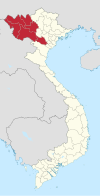Mù Cang Chải district
Mu Cang Chai district
Huyện Mù Cang Chải | |
|---|---|
UTC+7 (UTC + 7) | |
| Website | mucangchai |
Mù Cang Chải is a
Mù Cang Chải is a landlocked district that borders Van Ban district of Lao Cai province to the north, Muong La district of Son La province to the south, Than Uyen of Lai Chau province to the west, and Van Chan district of Yen Bai province to the east. The district is located at the foot of Hoang Lien Son mountain range, at an altitude of 1,000 m above sea level. To get to Mù Cang Chải district, travellers must pass through Khau Phạ Pass, which is one of four imposing passes in northwest Vietnam.
Administrative divisions
Mù Cang Chải is divided into 14 commune-level sub-divisions, including the township of Mù Cang Chải and 13 rural communes (Cao Phạ, Chế Cu Nha, Chế Tạo, Dế Xu Phình, Hồ Bốn, Khao Mang, Kim Nọi, La Pán Tẩn, Lao Chải, Mồ Dề, Nậm Có, Nậm Khắt, Púng Luông).
Climate
| Climate data for Mù Cang Chải | |||||||||||||
|---|---|---|---|---|---|---|---|---|---|---|---|---|---|
| Month | Jan | Feb | Mar | Apr | May | Jun | Jul | Aug | Sep | Oct | Nov | Dec | Year |
| Record high °C (°F) | 29.0 (84.2) |
30.3 (86.5) |
34.0 (93.2) |
34.2 (93.6) |
34.0 (93.2) |
33.5 (92.3) |
32.9 (91.2) |
33.0 (91.4) |
33.0 (91.4) |
31.0 (87.8) |
30.0 (86.0) |
28.6 (83.5) |
34.2 (93.6) |
| Mean daily maximum °C (°F) | 19.0 (66.2) |
21.3 (70.3) |
24.8 (76.6) |
27.3 (81.1) |
28.0 (82.4) |
27.4 (81.3) |
27.2 (81.0) |
27.4 (81.3) |
26.8 (80.2) |
25.1 (77.2) |
22.1 (71.8) |
19.4 (66.9) |
24.7 (76.5) |
| Daily mean °C (°F) | 12.9 (55.2) |
14.7 (58.5) |
18.1 (64.6) |
21.0 (69.8) |
22.5 (72.5) |
23.0 (73.4) |
22.9 (73.2) |
22.7 (72.9) |
21.7 (71.1) |
19.6 (67.3) |
16.3 (61.3) |
13.2 (55.8) |
19.1 (66.4) |
| Mean daily minimum °C (°F) | 9.2 (48.6) |
10.5 (50.9) |
13.4 (56.1) |
16.7 (62.1) |
19.1 (66.4) |
20.5 (68.9) |
20.4 (68.7) |
19.8 (67.6) |
18.4 (65.1) |
16.1 (61.0) |
12.6 (54.7) |
9.2 (48.6) |
15.5 (59.9) |
| Record low °C (°F) | −2.8 (27.0) |
−0.2 (31.6) |
1.3 (34.3) |
6.8 (44.2) |
11.2 (52.2) |
12.8 (55.0) |
15.0 (59.0) |
15.0 (59.0) |
11.7 (53.1) |
5.7 (42.3) |
1.9 (35.4) |
−3.6 (25.5) |
−3.6 (25.5) |
| Average precipitation mm (inches) | 28.5 (1.12) |
32.1 (1.26) |
63.4 (2.50) |
129.5 (5.10) |
215.1 (8.47) |
344.0 (13.54) |
383.7 (15.11) |
313.5 (12.34) |
132.3 (5.21) |
64.0 (2.52) |
35.4 (1.39) |
24.2 (0.95) |
1,760.1 (69.30) |
| Average rainy days | 4.9 | 5.3 | 7.6 | 13.7 | 18.9 | 24.2 | 26.1 | 23.0 | 15.1 | 10.4 | 5.6 | 4.0 | 159.4 |
| Average relative humidity (%)
|
79.9 | 77.3 | 73.7 | 74.6 | 78.9 | 84.3 | 86.1 | 85.5 | 82.8 | 81.3 | 80.5 | 80.3 | 80.5 |
| Mean monthly sunshine hours | 157.2 | 160.5 | 188.8 | 193.5 | 173.1 | 105.8 | 114.6 | 135.5 | 146.0 | 145.4 | 155.8 | 163.4 | 1,832.8 |
| Source: Vietnam Institute for Building Science and Technology[3] | |||||||||||||
Geography
Rice terrace fields
Local farmers needed to develop special water distribution channels to deal with the lack of water and the high altitude topography.
The water source of the fields comes from the upper streams and waterfalls. At low points in the mountain, water must be moved from higher places. Bamboo is cut in half and used as a tool to transfer water into the fields using gravity.[4] The water is moved into the first terrace, and then a gate is opened to make the water flow into the next terrace. This process avoids flooding the fields and retains the soil fertility. To create the contour of each piece of land, the Hmong people balance each terrace by water that people will point out a high place that is moved up on the coast and moved down to the low land so the fields surrounding hills are water level and the same height, creating the rice terraces of the mountain.
Since they were designated a
Gallery
References
- ^ ISBN 978-604-75-1532-5.
- ^ "Districts of Vietnam". Statoids. Retrieved March 23, 2009.
- ^ "Vietnam Institute for Building Science and Technology" (PDF). Retrieved 16 August 2023.
- ^ a b c "Rice terraces in Mu Cang Chai, Vietnam: Implementation of community-based tourism". International Centre for the Study of the Preservation and Restoration of Cultural Property. 13 Jun 2018. Retrieved 2 June 2022.
External links
- "Vietnam Photo Tour". Luminous Journeys.
- "Vietnam: Mù Cang Chải Travel & Tours". Impress Travel.
















